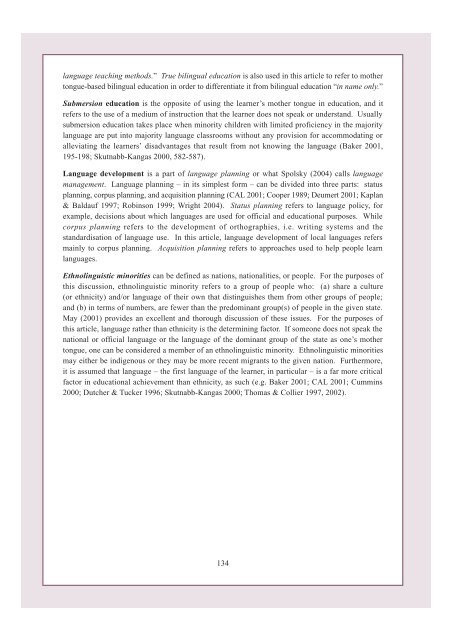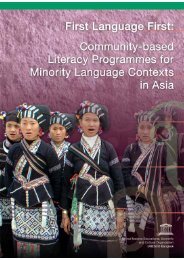Part II.pdf - MTB-MLE Network
Part II.pdf - MTB-MLE Network
Part II.pdf - MTB-MLE Network
Create successful ePaper yourself
Turn your PDF publications into a flip-book with our unique Google optimized e-Paper software.
language teaching methods.” True bilingual education is also used in this article to refer to mother<br />
tongue-based bilingual education in order to differentiate it from bilingual education “in name only.”<br />
Submersion education is the opposite of using the learner’s mother tongue in education, and it<br />
refers to the use of a medium of instruction that the learner does not speak or understand. Usually<br />
submersion education takes place when minority children with limited proficiency in the majority<br />
language are put into majority language classrooms without any provision for accommodating or<br />
alleviating the learners’ disadvantages that result from not knowing the language (Baker 2001,<br />
195-198; Skutnabb-Kangas 2000, 582-587).<br />
Language development is a part of language planning or what Spolsky (2004) calls language<br />
management. Language planning – in its simplest form – can be divided into three parts: status<br />
planning, corpus planning, and acquisition planning (CAL 2001; Cooper 1989; Deumert 2001; Kaplan<br />
& Baldauf 1997; Robinson 1999; Wright 2004). Status planning refers to language policy, for<br />
example, decisions about which languages are used for official and educational purposes. While<br />
corpus planning refers to the development of orthographies, i.e. writing systems and the<br />
standardisation of language use. In this article, language development of local languages refers<br />
mainly to corpus planning. Acquisition planning refers to approaches used to help people learn<br />
languages.<br />
Ethnolinguistic minorities can be defined as nations, nationalities, or people. For the purposes of<br />
this discussion, ethnolinguistic minority refers to a group of people who: (a) share a culture<br />
(or ethnicity) and/or language of their own that distinguishes them from other groups of people;<br />
and (b) in terms of numbers, are fewer than the predominant group(s) of people in the given state.<br />
May (2001) provides an excellent and thorough discussion of these issues. For the purposes of<br />
this article, language rather than ethnicity is the determining factor. If someone does not speak the<br />
national or official language or the language of the dominant group of the state as one’s mother<br />
tongue, one can be considered a member of an ethnolinguistic minority. Ethnolinguistic minorities<br />
may either be indigenous or they may be more recent migrants to the given nation. Furthermore,<br />
it is assumed that language – the first language of the learner, in particular – is a far more critical<br />
factor in educational achievement than ethnicity, as such (e.g. Baker 2001; CAL 2001; Cummins<br />
2000; Dutcher & Tucker 1996; Skutnabb-Kangas 2000; Thomas & Collier 1997, 2002).<br />
134
















